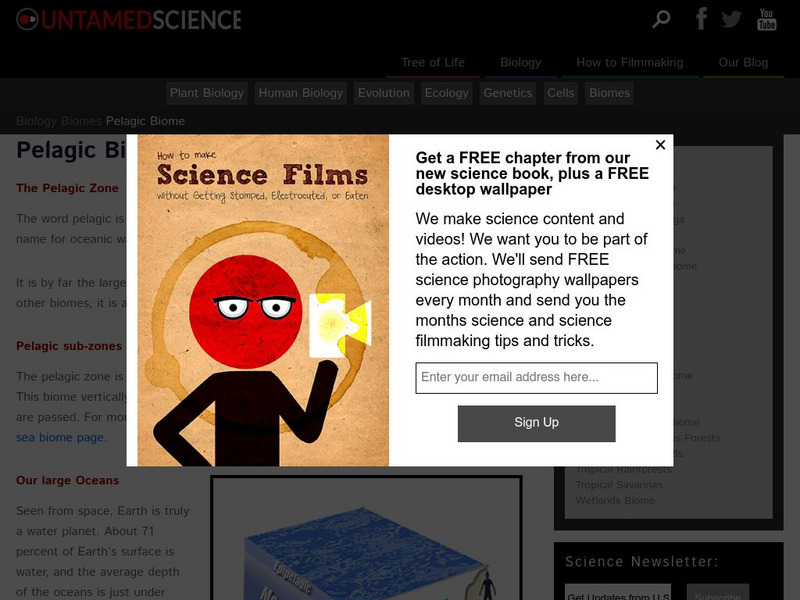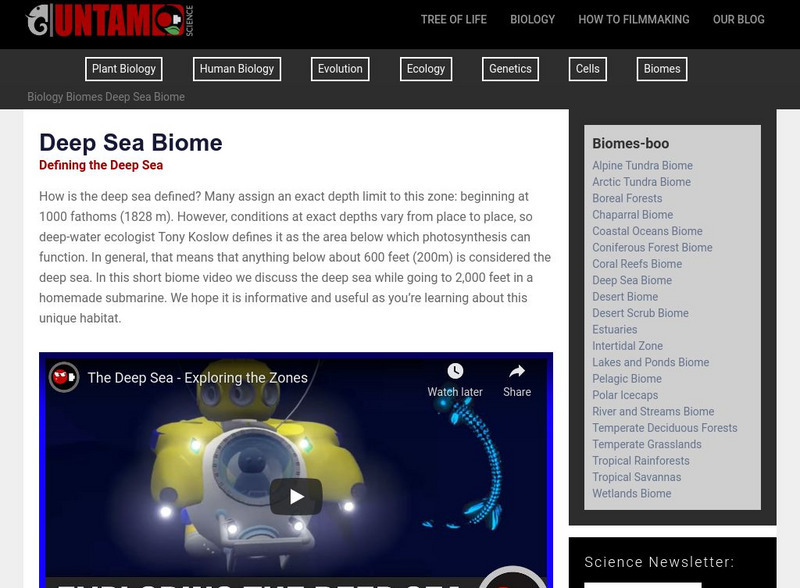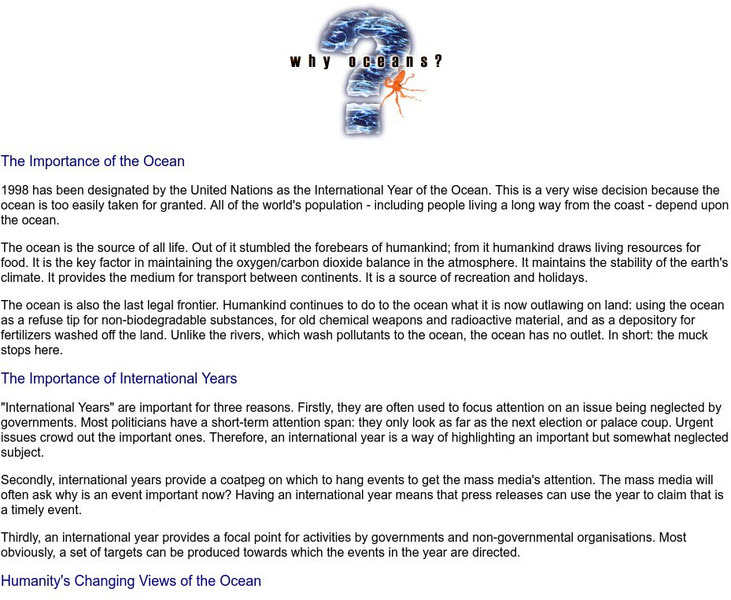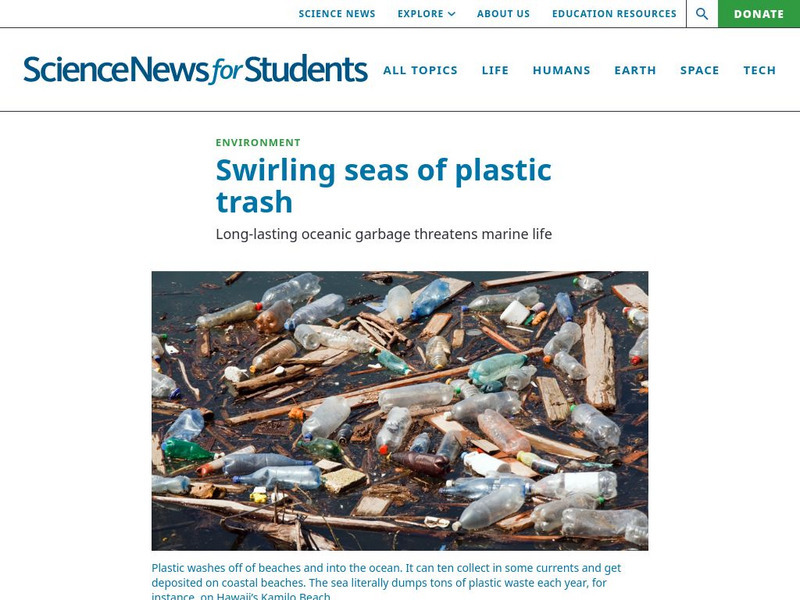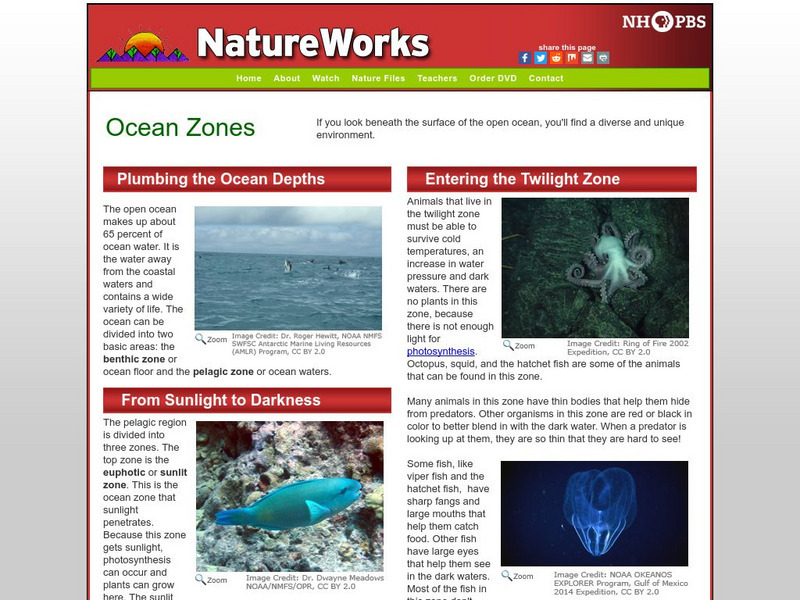Hi, what do you want to do?
Alabama Learning Exchange
Alex: Diverse Life Forms of the Ocean
This lesson allows students to view and draw conclusions on the importance of life in the ocean. It uses student created movies to explore what is going on, as well as identifying the zones and diverse life associated with the oceans....
CK-12 Foundation
Ck 12: Life Science: Aquatic Biomes
[Free Registration/Login may be required to access all resource tools.] Aquatic biomes can be generally classified based on the amount of salt in the water. Freshwater biomes have less than 1% salt and are typical of ponds and lakes,...
Untamed Science
Untamed Science: Biology: World Biomes: Pelagic Biome
Learn about the different zones of the open ocean, the pelagic biome, and what organisms call each zone home.
Other
Nesdis: Investigating Oceans: Algae Blooms
Explore how scientists use satellite data to detect and monitor Harmful Algal Blooms (HABs). HABs can be toxic to both humans and marine life. Students will learn how to read and interpret satellite images to better understand HAB events.
Untamed Science
Untamed Science: Biology: World Biomes: Deep Sea Biome
Read about the different zones and life in the deep sea as well as watch videos and examine photos of this aquatic biome. [5:54]
CK-12 Foundation
Ck 12: Earth Science: Paleozoic and Mesozoic Seas
[Free Registration/Login may be required to access all resource tools.] Reveals that during the Paleozoic and Mesozoic, six marine transgressions and regressions caused sea level to rise over the continents, leaving evidence in rocks in...
Smithsonian Institution
National Museum of Natural History: Ocean Portal, You Navigate
Delight in the fresh colors, sights, and sounds on this dynamic site on the ocean. Major categories consist of Ocean Life & Ecosystems, The Ocean Over Time, Ocean Science, and The Ocean and You. New information on sharks, a slideshow...
Untamed Science
Untamed Science: Biology: World Biomes: Coastal Oceans Biome
Explore photos, watch video clips, and learn about the aquatic biome located above the continental shelf. [8:37]
Exploring Nature
Exploring Nature Educational Resource: Oceans of the World
A set of illustrated fact pages, and some activity sheets, on coral reefs, tidal pools, and ocean ecosystems. Find maps, graphic organizers, and a movie link to tidal zones. Hyperlinks to specialized vocabulary words are also provided....
The Franklin Institute
In Quiry Almanack: Undersea and Oversee
Dive into a greater understanding of the oceans by tagging along on this exploration of the oceans.
NOAA
Noaa: Ocean Science Careers
Study the different types of ocean related careers that are available and how you can make a difference without having to be a professional.
Science Struck
Science Struck: Decomposers in the Ocean: Role and Examples
Describes five different types of decomposers that feed on decaying organic matter in the oceans and that are at the bottom of the ocean food chain.
CK-12 Foundation
Ck 12: Earth Science: Paleozoic and Mesozoic Seas
[Free Registration/Login may be required to access all resource tools.] How shallow seas appeared and disappeared throughout the Paleozoic Era.
Open Curriculum
Open Curriculum: Aquatic Biomes
This study information describes how aquatic biomes are divided into zones, and lists types of aquatic organisms.
CK-12 Foundation
Ck 12: Plate Tectonics and Seas of the Paleozoic and Mesozoic Era Study Guide
[Free Registration/Login may be required to access all resource tools.] Provides a brief overview of plate tectonic activity during the Paleozoic and Mesozoic eras and the changes in sea level that occurred. Includes some questions to...
US Senate
Us Senate Committee Commerce, Science and Transportation
The Senate Committee on Commerce, Science and Transportation has jurisdiction over several areas. Come and find out more about this powerful committee by checking out this resource.
Center for Educational Technologies
Nasa Classroom of the Future: Coral Reefs: Dissappearing Resource
Why are the reefs disappearing? Use this site to explore the science behind the issue. Useful at several grade levels.
Australian Broadcasting Corporation
Australian Broadcasting Corporation: Why Oceans?
This site, which is provided for by the Australian Broadcasting Corporation, gives an article on the importance of the ocean. Everyone on earth depends upon the oceans. Learn why oceans are important and what Australia is doing to help...
Scholastic
Scholastic: Study Jams! Science: Earth's Oceans
Oceans contain 97% of the water on the Earth and are home to a huge number of living creatures. View an informative slideshow of the ocean and its inhabitants and then test yourself on what you learned.
Australian Broadcasting Corporation
Australian Broadcasting Corporation: Monsters of the Deep: Tons of Tentacles
Read about octopuses and squids. Learn about their tentacles and other parts of the body.
Society for Science and the Public
Science News for Students: Swirling Seas of Plastic Trash
Describes the multitude of plastic trash scientists have found on a beach in Hawaii and in the oceans. Explains what a gyre is, and how plastic trash gets trapped in the eye of a gyre. Looks at the serious impact plastic materials have...
ClassFlow
Class Flow: Ocean Life
[Free Registration/Login Required] This flipchart is a multi-subject themed primary unit around the concept of oceans. Reading, Math, Science and Social Studies activities revolve around an ocean theme. In Part 5, students work on...
PBS
Nh Pbs: Nature Works: Ocean Zones
Discover more about the underocean environment at this site that surveys animals, environmental factors such as light and temperature, currents, animals, plants, and the like.
The Franklin Institute
The Franklin Institute: Treasures at Sea
Learn about ocean systems and habitats. Lots of reading, writing, games, and interactive activities. Colorful and fun.







